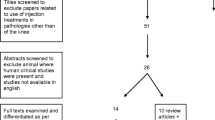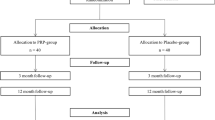Abstract
Purpose
Total knee arthroplasty (TKA) is often associated with major postoperative blood loss, postoperative pain, and impaired wound healing. The application of autologous platelet gel (APG), prepared from the buffy coat of a unit of autologous blood, has been advocated to improve haemostasis after surgery, to decrease perioperative blood loss, diminish postoperative pain and to enhance the wound healing process. This randomized controlled pilot study was developed to assess the effects of APG after total knee arthroplasty on blood loss, wound healing, pain, range of motion, and hospital stay.
Method
A prospective, randomized observer blind controlled trial was performed. Forty patients with only osteoarthritis of the knee were scheduled to have a TKA, and they were randomized into two groups. Patients in the treatment group were all treated with the application of autologous platelet gel after the prosthesis was implanted. Patients in the control group were treated with the same protocol but no APG was used.
Results
Preoperative and postoperative Hb levels showed no significant difference and allogenic blood transfusions were not given in either group. Haematomas were significantly larger in the control group than in the platelet gel group (P = 0.03). The pain score at rest was higher in the control group on the 3rd day (P = 0.04). Wound healing disturbances were seen in four patients in the control group and in no patients in the APG group (n.s.). Range of motion of the knee was similar postoperatively. Hospital stay was 6.2 days in the APG and 7.5 days in the control group (n.s.).
Conclusion
In this prospective randomized pilot study on APG in total knee arthroplasty, differences in favour of the use of platelet gel were found, but these were subjective evaluations, marginal in effect, or did not reach statistical significance. The use of drains might have decreased the concentration of delivered platelets and may have diminished the effect. However, in this study, a statistically significant clinically important effect in favour of platelet gel application was not found. Further studies with larger numbers of patients, and without the use of drains, are warranted to investigate the possible benefits of autologous platelet gel in total knee arthroplasty.
Similar content being viewed by others

References
Adler SC, Kent KJ (2000) Enhancing wound healing with growth factors. Facial Plast Surg Clin North Am 10:129–146
Anitua E, Andia I, Ardanza B (2004) Autologous platelets as a source of proteins for healing and tissue regeneration. Thromb Haemost 91:4–15
Berghoff WJ, Pietrzak WS, Rhodes RD (2006) Platelet-rich plasma application during closure following total knee arthroplasty. Orthopedics 29:590–598
Bielecki TM, Gazdzik TS, Szczepanski T (2008) Benefit of percutaneous injection of autologous platelet-leukocyte-rich gel in patients with delayed union and nonunion. Eur Surg Res 40:289–296
Bielecki TM, Gazdzik TS, Arendt J, Szczepanski T, Król Wielkoszynski T W, Wielkoszynski T (2007) Antibacterial effect of autologous platelet gel enriched with growth factors and other active substances: an in vitro study. J Bone Joint Surg Br 89:417–420
Bierbaum BE, Callaghan JJ, Galante JO, Rubash HE, Tooms RE, Welch RB (1999) An analysis of blood management in patients having a total hip or knee arthroplasty. J Bone Joint Surg Am 81:2–10
Blumberg N (1997) Allogeneic transfusion and infection: economic and clinical implications. Semin Hematol 34:34–40
Crovetti G, Martinelli G, Issi M, Barone M, Guizzardi M, Campanati B, Moroni M, Carabelli A (2004) Platelet gel for healing cutaneous chronic wounds. Transfus Apher Sci 30:145–151
Dennis DA (2002) Wound complications in TKA. Orthopedics 25:973–974
Driver VR, Hanft J, Fylling CP, Beriou JM (2006) Autologel Diabetic Foot Ulcer Study Group. A prospective, randomized, controlled trial of autologous platelet-rich plasma gel for the treatment of diabetic foot ulcers. Ostomy Wound Manage 52:68–70 72, 74
Everts PA, Devilee RJ, Brown Mahoney C, Eeftinck-Schattenkerk M, Box HA, Knape JT, van Zundert A (2006) Platelet gel and fibrin sealant reduce allogeneic blood transfusions in total knee arthroplasty. Acta Anaesthesiol Scan 50:593–599
Everts PA, Devilee RJ, Oosterbos CJ, Mahoney CB, Schattenkerk ME, Knape JT, van Zundert A (2007) Autologous platelet gel and fibrin sealant enhance the efficacy of total knee arthroplasty: improved range of motion, decreased length of stay and a reduced incidence of arthrofibrosis. Knee Surg Sports Traumatol Arthrosc 15:888–894
Everts PA, Devilee RJ, Brown Mahoney C, van Erp A, Oosterbos CJ, Stellenboom M, Knape JT, van Zundert A (2008) Exogenous application of platelet-leukocyte gel during open subacromial decompression contributes to improved patient outcome. A prospective randomized double-blind study. Eur Surg Res 40:203–210
Everts PA, Overdevest EP, Jakimowicz JJ, Oosterbos CJ, Schönberger JP, Knape JT, van Zundert A (2007) The use of autologous platelet-leukocyte gels to enhance the healing process in surgery, a review. Surg Endosc 21:2063–2068
Everts PA, Knape JT, Weibrich G, Schonberger JP, Hoffmann J, Overdevest EP, Box HA, van Zundert AJ (2006) Platelet-rich plasma and platelet gel: a review. J Extra Corpor Technol 38:174–187
Eppley B, Woodell JE, Higgins J (2004) Platelet quantification and growth factor analysis from platelet-rich plasma: implications for wound healing. Plast Reconstr Surg 114:1502–1508
Franchini M, Dupplicato P, Ferro I, De Gironcoli M, Aldegheri R (2005) Efficacy of platelet gel in reconstructive bone surgery. Orthopedics 28:161–163
Gandhi A, Bibbo C, Pinzur M, Lin SS (2005) The role of platelet-rich plasma in foot and ankle surgery. Foot Ankle Clin 10:621–637
Gardner MJ, Demetrakopoulos D, Klepchick PR, Mooar PA (2007) The efficacy of autologous platelet gel in pain control and blood loss in total knee arthroplasty: an analysis of the haemoglobin, narcotic requirement and range of motion. Int Orthop 31:309–313
Goodnough LT (2003) Riks of blood transfusion. Crit Care Med 31:S678–S686
Hom DB, Linzie BM, Huang TC (2007) The healing effects of autologous platelet gel on acute human skin wounds. Arch Facial Plast Surg 9:174–183
Innerhofer P, Klingler A, Klimmer C, Fries D, Nussbaumer W (2005) Risk for postoperative infection after transfusion of white blood cell-filtered allogeneic or autologous blood components in orthopedic patients undergoing primary arthroplasty. Transfusion 45:103–110
Kevy SV, Jacobson MS (2004) Comparison of methods for point of care preparation of autologous platelet gel. J Extra Corpor Technol 36:28–35
Kirsner RS, Eaglstein WH (1993) The wound healing Process. Dermatol Clin 11:629–640
Levy O, Martinowitz U, Oran A, Tauber C, Horoszowski H (1999) The use of fibrin tissue adhesive to reduce blood loss and the need for blood transfusion after total knee arthroplasty. A prospective, randomized, multicenter study. J Bone Joint Surg Am 81:1580–1588
Lotke PA, Faralli VJ, Orenstein EM, Ecker ML (1991) Blood loss after total knee replacement. Effects of tourniquet release and continuous passive motion. J Bone Joint Surg Am 73:1037–1040
Margolis DJ, Kantor J, Santanna J, Strom BL, Berlin JA (2001) Effectiveness of platelet releasate for the treatment of diabetic neuropathic foot ulcers. Diabetes Care 24:483–488
Marmor L, Avoy DR, McCabe A (1991) Effect of fibrinogen concentrates on blood loss in total knee arthroplasty. Clin Orthop Relat Res 273:136–138
Marx RE, Carlson ER, Eichstaedt RM, Schimmele SR, Strauss JE, Georgeff KR (1998) Platelet Rich Plasma. Growth factor enhancement for bone grafts. Oral Surg Oral Med Oral Pathol Oral Radiol Endod 85:638–646
Marx RE (2004) Platelet-rich plasma: evidence to support its use. J Oral Maxillofac Surg 62:489–496
Mazzucco L, Medici D, Serra M, Panizza R, Rivara G, Orecchia S, Libener R, Cattana E, Levis A, Betta PG, Borzini P (2004) The use of autologous platelet gel to treat difficult-to-heal wounds: a pilot study. Transfusion 44:1013–1018
McAleer JP, Kaplan E, Persich G (2006) Efficacy of concentrated autologous platelet-derived growth factors in chronic lower-extremity wounds. J Am Podiatr Med Assoc 96:482–488
Menderes A, Demirdover C, Yilmaz M, Vayvada H, Baratcu A (2002) Reconstruction of soft tissue defects following total knee arthroplasty. Knee 9:215–219
Mishra A, Pavelko T (2006) Treatment of chronic elbow tendinosis with buffered platelet-rich plasma. Am J Sports Med 34:1774–1778
Molloy DO, Archbold HA, Ogonda L, McConway J, Wilson RK, Beverland DE (2007) Comparison of topical fibrin spray and tranexamic acid on blood loss after total knee replacement: a prospective, randomised controlled trial. J Bone Joint Surg Br 89:306–309
Moojen DJ, Everts PA, Schure RM, Overdevest EP, van Zundert A, Knape JT, Castelein RM, Creemers LB, Dhert WJ (2008) Antimicrobial activity of platelet-leukocyte gel against Staphylococcus aureus. J Orthop Res 26:404–410
Newman JH, Bowers M, Murphy J (1997) The clinical advantages of autologous transfusion. A randomized, controlled study after knee replacement. J Bone Joint Surg Br 79:630–632
O’Connor MI (2004) Wound healing problems in TKA: just when you thought it was over!. Orthopedics 27:983–984
Pham CT (2006) Neutrophil serine proteases: specific regulators of inflammation. Nat Rev Immunol 6:541–550
Sehat KR, Evans R, Newman JH (2000) How much blood is really lost in total knee arthroplasty? Correct blood loss management should take hidden loss into account. Knee 7:151–155
Slappendel R, Dirksen R, Weber EW, van der Schaaf DB (2003) An algorithm to reduce allogeneic red blood cell transfusions for major orthopedic surgery. Acta Orthop Scand 74:569–575
Trowbridge CC, Stammers AH, Woods E, Yen BR, Klayman M, Gilbert C (2005) Use of platelet gel and its effects on infection in cardiac surgery. J Extra Corpor Technol 37:381–386
Vince KG, Abdeen A (2006) Wound problems in total knee arthroplasty. Clin Orthop Relat Res 452:88–90
Wang GJ, Hungerford DS, Savory CG, Rosenberg AG, Mont MA, Burks SG, Mayers SL, Spotnitz WD (2001) Use of fibrin sealant to reduce bloody drainage and hemoglobin loss after total knee arthroplasty. J Bone Joint Surg Am 83:1503–1505
Zavadil DP, Satterlee CC, Costigan JM, Holt DW, Shostrom VK (2007) Autologous platelet gel and platelet-poor plasma reduce pain with total shoulder arthroplasty. J Extra Corpor Technol 39:177–182
Author information
Authors and Affiliations
Corresponding author
Rights and permissions
About this article
Cite this article
Horstmann, W.G., Slappendel, R., van Hellemondt, G.G. et al. Autologous platelet gel in total knee arthroplasty: a prospective randomized study. Knee Surg Sports Traumatol Arthrosc 19, 115–121 (2011). https://doi.org/10.1007/s00167-010-1207-0
Received:
Accepted:
Published:
Issue Date:
DOI: https://doi.org/10.1007/s00167-010-1207-0



